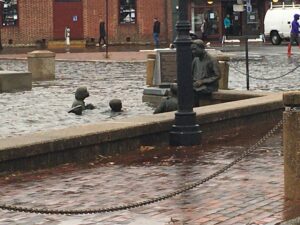Earth Day was first celebrated on this day in 1970 when 20 million people attended events at sites across the United States. Originally designed to fight for environmental causes, today’s Earth Day mission is to diversify, educate and activate the environmental movement worldwide. We’re taking a deep dive into the preservation issues associated with sea level rise with a guest blog from Benjamin Curran, Curriculum Developer for The Campaign for Historic Trades, powered by Preservation Maryland.
INCREASES IN MEAN SEA LEVEL (MSL) WITHIN THIS CENTURY ARE EXPECTED TO HAVE PROFOUND AND CATASTROPHIC IMPACTS ON COASTAL REGIONS CHARACTERIZED AS LOW ELEVATION COASTAL ZONES (LECZ).
From the stand point of historic preservation, the growing threat of sea level rise (SLR) due to climate change will pose monumental challenges to the retention and preservation of our coastal cultural heritage. Though inundation, erosion, and storm surge will pose the most notable and visible dangers to the built landscape, it will be the slow, insidious, and progressive lifting of the coastal freshwater lens that will undermine historic structures integrity decades in advance.

Outside of Preservation Maryland’s Historic Property Project, Burtis House, after a storm in October 2021. Preservation Maryland’s work will include safeguarding the building from coastal flooding via elevation of the structure to align with the sea level rise resiliency objectives
Coastal ground water (GW), also known as a freshwater lens, floats on top of a bed of salt water that intrudes into the terra firma of our coastlines. As tides ebb and flow, the freshwater lens moves up and down in unison. Given the correlation between tidal pressure and GW height, structural components/materials that have existed below ground level and remained dry, will be increasingly affected by exposure to freshwater and, in some instances saltwater. This relationship is illustrated well in the YouTube video which shows the flooding of a basement at the Strawbery Banke Museum in Portsmouth, NH. The museum first installed water level data loggers in 2010 to assess the impacts of sea level rise on the sites water table.
THE PRESERVATION ISSUES ASSOCIATED WITH THE ELEVATION OF THE GROUND WATER BY SLR WILL DEPEND, IN PART, ON THE AMOUNT WATER AND FREQUENCY OF EXPOSURE THAT THE MATERIALS ARE SUBJECTED TO.
Some of the effects to subsurface building components may include leaching and efflorescence of mortars components, destabilization of brick and stone masonry foundations and chimneys, salinization of masonry and subsequent increased susceptibility to freeze/thaw cycles. Foundations of structures may start shifting due to changes in hydrology and drainage. Historic decorative coatings or finishes such as plaster, lime wash, white wash, and distemper may fail due to increased wetting or salinization of their substrate. Historic metalwork, such as nails, screws, hinges, handles, fasteners, and hardware may experience accelerated corrosion and could result in damage to surrounding materials. Wooden materials subjected to more frequent wetting, salinization, or rising damp may show increased signs of deterioration due to defibration, staining, failure of finish materials, or rot. Differences in the soil matrix surrounding out-of-service sewer, gas, and/or water lines can act as conduits for water pressurized by tides straight to historic structures.
Regardless of the underlying materials, many of these issues are already being experienced at coastal historic sites and will only get worse. In order to better understand the scope and magnitude of the effects of climate change and sea level rise on coastal cultural heritage, it is imperative that we focus more attention on initiating and supporting place-based monitoring and assessment projects. Though such endeavors may lack the gratification of a new curatorial or interpretive project, the impact may determine the sustainability of a site or structure over the long term.
A NEW RESEARCH PROJECT, CURRENTLY FUNDED BY A HARRISON GOODALL FELLOWSHIP, IS INVESTIGATING THE VIABILITY OF DEVELOPING AND DEPLOYING A LOW COST SUITE OF SENSORS, CONSTRUCTED OF READILY AVAILABLE OFF-THE-SHELF ELECTRONICS THAT CAN BE USED TO MONITOR THE IMPACTS OF SEA LEVEL RISE ON GW LEVELS AT COASTAL CULTURAL HERITAGE SITES.
Recent development in sensors and open-source hardware technologies enable the development of inexpensive smart sensors for flow, salinity, and temperature. Water level (often a proxy for flow), along with salinity and temperature are fundamental parameters relevant to understanding hydrologic processes and their effect by climate change and sea level rise. The movement of GW levels is an important byproduct of the interactions between freshwater and saltwater in coastal aquifers and can tell us a lot about SLR induced intrusion, inundation, and seepage observed in and around coastal historic structures.
Currently researchers use expensive sensor equipment, making their distribution and use limited in application. This is just one more financial obstacle for many impoverished and underrepresented communities and further disenfranchises community members trying to reconcile the loss of their “sense of place.” This project is focused on building protocols for the creation and deployment of low cost, readily available, open-source, monitoring and dissemination technologies to better understand the GW dynamics of sea level rise at historic coastal cultural heritage sites. It is the hope that this project will lay the foundation for a STEM based curriculum that engages high school students through the construction, installation, and monitoring of systems. Data collected could be used by architects, engineers, planners, and preservationists to better understand the dynamic relationship between the built landscape and SLR-induced ground water elevation.
